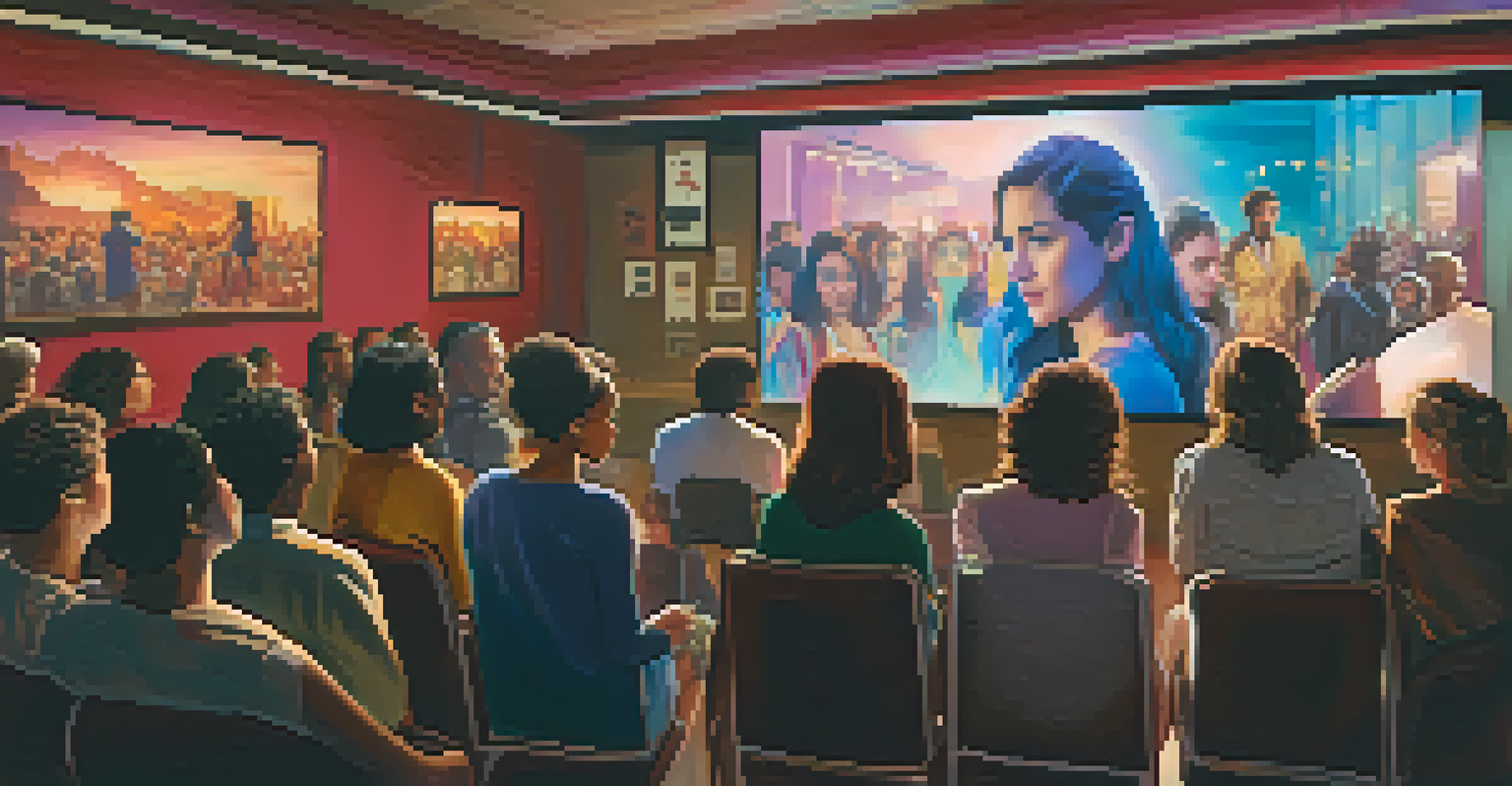How Film Influences Gender Roles in Contemporary Society

The Role of Film as a Cultural Mirror
Film serves as a powerful reflection of society, often showcasing prevailing gender roles. By portraying diverse characters and their relationships, films can either reinforce or challenge traditional norms. For instance, movies like 'Wonder Woman' illustrate strong female protagonists, shifting the narrative from passive to powerful.
Film is a powerful medium that can shape our perceptions of gender roles and identities.
As audiences engage with these narratives, they begin to see different possibilities for gender expression. This shift can lead to broader acceptance of various identities and roles within society. Consequently, films not only entertain but also educate viewers about evolving gender dynamics.
Moreover, the stories we tell through film can influence real-world perceptions, making it crucial for filmmakers to consider their impact. When films challenge stereotypes, they can inspire social change and encourage new conversations about gender roles.
Stereotypes Reinforced by Cinema
Despite the progress in recent years, many films still perpetuate outdated stereotypes. For example, the 'damsel in distress' trope frequently surfaces, portraying women as helpless and dependent on male heroes. This not only limits how female characters are developed but can also shape societal expectations regarding gender roles.

These stereotypes can have a lasting impact on how audiences view gender in their everyday lives. When young viewers see repeated portrayals of women as submissive or men as aggressive, it can influence their beliefs and behaviors. Such representations reinforce traditional roles that may hinder gender equality.
Film Reflects and Shapes Society
Movies serve as a cultural mirror that can reinforce or challenge traditional gender roles, influencing how audiences perceive and engage with these dynamics.
In essence, while film can be a medium for change, it can also contribute to the stagnation of outdated norms. Recognizing these patterns allows us to critically assess the media we consume and advocate for more balanced representations.
Impact of Diverse Representation in Film
Diversity in film is crucial for challenging traditional gender roles and providing broader narratives. Films that feature a range of backgrounds and experiences help to normalize different identities and roles. For example, movies like 'Moonlight' and 'Black Panther' highlight varied male experiences, moving beyond the traditional heroic archetype.
Diversity in storytelling is essential for creating relatable characters and authentic narratives.
This representation is vital for underrepresented groups, as it fosters a sense of belonging and visibility. When diverse characters are portrayed authentically, they can resonate with audiences, allowing for more nuanced understandings of gender and identity. This, in turn, encourages viewers to embrace diversity in their own lives.
Ultimately, by showcasing a wide array of characters and stories, films can inspire audiences to rethink and redefine gender roles. The more we see ourselves and our experiences reflected on screen, the more we can challenge societal norms that limit us.
The Role of Female Filmmakers
Female filmmakers play a crucial role in reshaping gender narratives within the film industry. By bringing their unique perspectives to storytelling, they challenge the status quo and create more relatable characters for women. Films directed by women often highlight complex female experiences, such as those seen in 'Lady Bird' and 'The Farewell'.
These narratives can resonate deeply with audiences, as they reflect authentic experiences that have long been overlooked. By centering women's stories, female filmmakers not only empower their characters but also inspire future generations to explore their own voices. This representation is vital in broadening the conversation around gender roles.
Diversity Enhances Gender Narratives
Incorporating diverse representation in film fosters greater authenticity and allows for a broader understanding of gender identities and experiences.
The increasing visibility of female directors and writers is a promising trend, suggesting that the industry is slowly moving toward a more equitable landscape. As more women take the helm, we can expect to see a richer variety of gender representations in film.
Social Media and Film's Gender Narratives
The rise of social media has added a new layer to how film influences gender roles. Platforms like Twitter and Instagram allow audiences to discuss and critique films in real-time. This immediate feedback can hold filmmakers accountable for their portrayals of gender, encouraging them to create more thoughtful content.
Moreover, social media campaigns often spotlight problematic representations, pushing for changes in future productions. Hashtags like #TimesUp and #MeToo have shed light on gender inequalities within the industry, influencing how stories are told. Audiences increasingly demand more accurate and diverse representations, and filmmakers are responding.
As social media continues to evolve, it empowers viewers to engage deeply with the content they consume. This interaction not only shapes public perception but also drives the industry toward more inclusive narratives, ultimately impacting how gender roles are portrayed in film.
The Influence of Genre on Gender Roles
Different film genres often depict gender roles in unique ways, shaping audience expectations. For example, action films typically highlight male heroism, while romantic comedies often center on female relationships and emotional journeys. These genre conventions can reinforce specific stereotypes, impacting how viewers perceive gender behavior.
However, genre-blending films challenge these conventions by introducing unexpected character dynamics. Movies like 'Mad Max: Fury Road' and 'Frozen' defy traditional genre roles, showcasing strong female leads in action-oriented scenarios. These narratives broaden the scope of what is considered acceptable for different genders, encouraging new ways of thinking.
Female Filmmakers Drive Change
The rise of female filmmakers is crucial in reshaping gender narratives, bringing unique perspectives that empower women and challenge outdated norms.
By understanding how genre influences gender representation, we can better appreciate the complexity of film narratives. This awareness allows audiences to critically engage with films and advocate for more varied and progressive portrayals across all genres.
Future Directions for Gender Representation in Film
As society continues to evolve, so too must the representations of gender in film. The push for more inclusive and diverse narratives is gaining momentum, with a growing demand for stories that reflect a broad spectrum of gender identities. Filmmakers are beginning to recognize the importance of authenticity, striving to create characters that resonate with real-life experiences.
This shift is not only beneficial for audiences but also for the industry itself. Diverse storytelling can lead to richer narratives and greater audience engagement, ultimately driving box office success. As we move forward, it's essential for filmmakers to embrace this change and continue pushing boundaries.

The future of gender representation in film looks promising, with ongoing conversations about inclusivity and equity. By supporting films that challenge traditional roles, audiences can play a vital role in shaping a more progressive cinematic landscape.